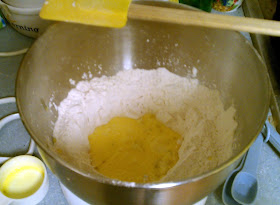To
download a cookbook-style copy of the recipe for Chicken Piccata Ravioli, click
HERE.
 A meal of homemade ravioli can be as satisfying to make as
it is to serve and eat. It also affords some great opportunities to be creative
with your fillings and sauces.
A meal of homemade ravioli can be as satisfying to make as
it is to serve and eat. It also affords some great opportunities to be creative
with your fillings and sauces.
With that in mind, today’s recipe takes Chicken Piccata, that
simple and very delicious restaurant favorite of browned chicken topped with a
white wine and lemon sauce (and that is often served over pasta), and uses it
as the basis for a unique, fresh ravioli dish. It’s a simple idea – the chicken
is used to make the filling, and the wine and lemon sauce is used to top the
finished ravioli – that’s a whole new way to look at ravioli.
Some Cook’s Notes before we begin.
- In the recipe below, we’ll be making our own pasta dough from scratch. It’s fun and not at all difficult, but if you still prefer not to make your own, store-bought wonton wrappers will work just fine.
- There are many ways of rolling and cutting pasta dough for ravioli. In the recipe below, I hand rolled the dough and used a ravioli stamp, but if you prefer other ways – rolling with a pasta machine, cutting with round cookie cutters, using a ravioli attachment on a stand mixer, etc. – feel free. The right way is any way that works for you.
- When we make the pasta dough in the recipe below, I combined the ingredients in a bowl. Some people do prefer the more traditional way of mixing the ingredients directly on the counter. As was the case with rolling and cutting the ravioli, there’s more than one way, and you should use any you prefer.
This recipe makes about 24 ravioli.
We’ll start by making the pasta dough. (Skip this step if
you’re using wonton wrappers.)
In a bowl, combine 2 cups all-purpose flour; ½ tsp salt; and 1 tsp dried sage. Make a well in the center of the mixture.
Mix until a dough forms. (Add a little more flour if the dough seems too moist, but not more than 1 Tbsp.) Knead by hand or using the dough hook of a mixer for about five minutes until dough is smooth and elastic.
While the dough is resting, begin making the filling.
Heat 1 Tbsp of olive oil in a skillet over medium-high heat. Add 3 Tbsp chopped shallots or onions, and sauté until translucent but not brown.
While
the filling is cooling, make the piccata sauce as described below.
Using the same pan you used to cook the chicken, reduce the heat to medium, and heat 1 Tbsp olive oil. When heated, sauté 2 chopped garlic cloves until aromatic, 30 seconds – 1 minute.
Now let’s make the ravioli! (Repeat the following steps for each of the dough quarters. Keep the unused dough covered to prevent drying out.)
On a well-floured surface, roll to a thickness of about 1/16”.
Place an identical shape on top, pressing down onto the egg. Press down edges with a fork or fingers to seal.
To serve, plate the ravioli and top with the sauce. Garnish with parsley. Serve with a salad or vegetable side dish.
To download a cookbook-style copy of the recipe for Chicken Piccata Ravioli, click HERE.
Whether
you’re making it for yourself or for company, this is a dinner you’ll be proud
to serve. Bon appétit!






















































